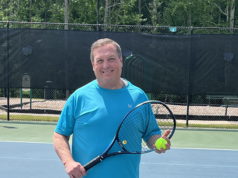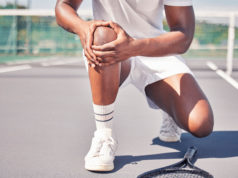Minimize your risk with a few, simple lifestyle changes.
By Shane Mangrum, MD, Polaris Spine & Neurosurgery Center
In tennis, as in life, it can be said that spin is everything. This fact is so central to the game that former #1 ranked player Samantha Stosur once said, “Tennis is all about rotation of the body and my ability to create power.”
Rotation helps to create power and topspin. But it also delivers stress to the musculoskeletal system. The impact of these stresses is seen in the high rates of injury reported amongst tennis players. One study stated that nearly 75 percent of all elite athletes playing overhead sports reported experiencing back pain during the last 12 months. (See PLOS ONE 14(1): e0210429.)
The lower back, while a commonplace to experience pain symptoms, is rarely the source of dysfunction. Rather, the issue typically is related to abnormal motions or forces transmitted from other parts. These breakdowns in function elsewhere cause the lower back to do excessive work until it calls out for attention. Several common factors that can feed into the development of low back pain or injury include the following:
- A lack of mobility in the ankles, hips, upper back or shoulders
- Overuse or overtraining
- Musculoskeletal imbalances or deficiencies
- Technical faults
- Equipment faults
- Environmental issues such as court surface type or training conditions
Strategies to prevent tennis injuries can include giving adequate time and attention to warm-up and cool-down phases; seeking out healthcare professionals trained to perform functional movement screens, this testing can help to identify areas of weakness or imbalance then sport and individual programs can be built to target your specific game and injury risk situation; building endurance and coordination in the essential stabilizing muscles of the back and core.
Speaking of spinning, as any tennis player worth their salt knows, body rotation is part of the game. Just think about your serve: Rotating your trunk and extending your spine to (hopefully!) produce a powerful serve requires a great deal of strength as well as flexibility. The hyperextension of the lower back can stress the three joints found at each level of the spine, as well as the lumbar discs. Strain also is placed on the soft tissues — muscles, ligaments, and tendons.
Core strength and flexibility: These should be an important focus of any fitness plan, but we often forget these “less sexy” components. Nevertheless, they play a key role in supporting and protecting your spinal column.
Consider your serve: The topspin serve is far harder on your body than the slice. Approaching the ball from the side rather than from above avoids much of the hyperextension of the lower back, as well as the lumbar disc compression. Maybe you don’t make that change for every serve to every opponent, but think about incorporating it into your game to give your back a break!
All backhands are not created equal: Learning a one-handed backhand can help you avoid the more extreme rotational stress on your spine that comes from the two-handed backhand. Much of the power of the two-handed backhand comes from that rotation, but learn to use it strategically. You might still want to whip out your power two-handed backhand, but perhaps reserve that for break point!
Surface of play: Softer tends to be better when it comes to your spine. Softer courts reduce the forces of the abrupt stops and starts inherent in our sport. While hard courts are usually easier to find, if you can find softer surfaces (“Har-Tru,” for example), use them!
Racket tension matters: The tension of your racket may be the last thing you would think about, when it comes to caring for your spine. However, the more flexible your racket, the more trunk rotation you need to create a powerful force when you swing.
Moreover, a racquet whose size isn’t appropriate for you may increase stress on your elbow, which can cause you to alter your swing and result in back pain from bad biomechanics. The goal is to get smarter about how we use our bodies, so we can keep doing what we love as long as we can!
For more information, visit polarisspine.com or follow us on our Facebook page.




